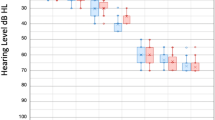Abstract
High frequency hearing loss is a growing problem for both children and adults. To overcome this impairment, different frequency lowering methods (FLMs) were tried from 1930s, however no satisfaction was provided up to now. In this study, for getting higher speech intelligibility, eight combinations of FLMs which were designed originally were tried with simulated sounds onto normal hearing subjects. These improvements were calculated by the difference with standard hearing aid method, amplification. High frequency hearing loss was simulated with the combined suprathreshold effects. An offline study was carried out for each subject for determining the significant methods used in modified rhyme test (MRT) (Subjective measure for intelligibility). Significant methods were determined according to their speech intelligibility index (SII) (Objective measure for intelligibility). All different cases were tried under four noisy environments and a noise free environment. Twelve hearing impaired subjects were simulated by hearing loss simulation (HLS). MRT was developed for Turkish language as a first time. As the results of improvements, total 71 cases were statistically significant for twelve subjects. Eighty-three percent success of FLMs was achieved against amplification for being an alternative method of amplification in noisy environments. For four subjects, all significant methods gave higher improvements than amplification. As conclusion, specific method recommendations for different noisy environments were done for each subject for getting more speech intelligibility.

Similar content being viewed by others
References
Bench, J., and Bamford, J., Speech-hearing tests and the spoken language of hearing-impaired children. Academic, London, 1979.
Ching, T. Y., Dillon, H., and Byrne, D., Speech recognition of hearing impaired listeners: predictions from audibility and the limited role of high-frequency amplification. J. Acoust. Soc. Am. 103:1128–1140, 1998.
Hogan, C. A., and Turner, C. W., High-frequency audibility: benefits for hearing-impaired listeners. J. Acoust. Soc. Am. 104(1):432–441, 1998.
Murray, N. B., and Byrne, D., Performance of hearing impaired and normal hearing listeners with various high frequency cut-offs in hearing aids. Aust. J. Audiol. 8:21–28, 1986.
Fowler, E. P., A method for the early dedection of otosclerosis. Arch. Otolaryngol. 24:731–741, 1936.
Baer, T., Moore, B. C., and Kluk, K., Effects of low pass filtering on the intelligibility of speech in noise for people with and without dead regions at high frequencies. J. Acoust. Soc. Am. 112:1133–1144, 2002.
Moore, B. C. J., and Glasberg, B. R., A model of loudness perception applied to cochlear hearing loss. Audit. Neurosci. 3:289–311, 1997.
Vickers, D. A., Baer, T., and Moore, B. C. J., Effects of lowpass filtering on speech intelligibility for listeners with dead regions at high frequencies. Br. J. Audiol. 35:148–149, 2001.
Robinson, J. D., Baer, T., and Moore, B. R. C., Using transposition to improve consonant discrimination and detection for listeners with severe high-frequency hearing loss. Int. J. Audiol. 46:293–308, 2007.
Simpson, A., Frequency-lowering devices for managing high-frequency hearing loss: a review. Trends Amplif. 13(2):87–106, 2009.
House, A. S., Williams, C. E., Hecker, M. H. L., and Kryter, K. D., Articulation testing methods: consonantal differentiation with a closed response set. J. Acoust. Soc. Am. 37:158–166, 1965.
ANSI-S3.5, American national standard methods for the calculation of the speech intelligibility index. American National Standards Institute, Inc, New York, 1997.
Moore, B. C. J., Glasberg, B. R., and Vickers, D. A., Simulation of the effects of loudness recruitment on the intelligibility of speech in noise. Br. J. Audiol. 29:131–143, 1995.
Nejime, Y., and Moore, B. C. J., Simulation of the effect of threshold elevation and loudness recruitment combined with reduced frequency selectivity on the intelligibility of speech in noise. J. Acoust. Soc. Am. 102:603–615, 1997.
Palaz, H., Bicil, Y., Kanak, A., and Dogan, M. U., New Turkish intelligibility test for assessing speech communication systems. J. Speech Commun. 47:411–423, 2005.
Author information
Authors and Affiliations
Corresponding author
Additional information
This article is part of the Topical Collection on Systems-Level Quality Improvement
Rights and permissions
About this article
Cite this article
Arıöz, U., Günel, B. Optimization of Frequency Lowering Algorithms for Getting the Highest Speech Intelligibility Improvement by Hearing Loss Simulation. J Med Syst 39, 64 (2015). https://doi.org/10.1007/s10916-015-0248-9
Received:
Accepted:
Published:
DOI: https://doi.org/10.1007/s10916-015-0248-9




